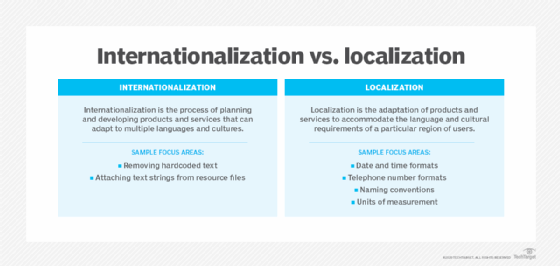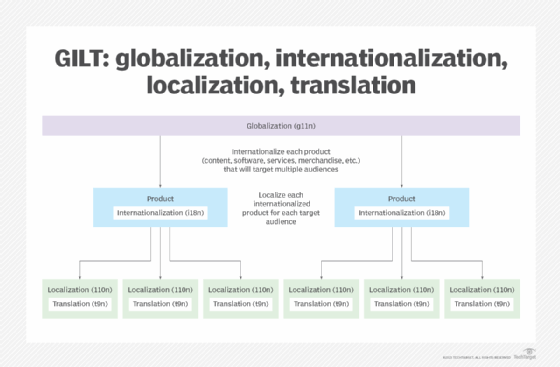localization (original) (raw)
What is localization?
Localization is the process of adapting and customizing a product to meet the needs of a specific market, as identified by its language, culture, expectations, local standards and legal requirements. Localization can apply to any type of merchandise or service that targets multiple audiences with different cultural backgrounds. The term localization is often represented as l10n, where 10 is the number of letters between the word's opening L and closing N.
Localization and translation are sometimes confused or treated as one and the same. However, localization transcends simply translating text into the local language. When localizing a product, an organization must address a wide range of issues to ensure the product is properly prepared for its target market, even if it's accompanied by an internationally recognizable brand.
A localized product should appear to have been developed specifically for the local culture. It should account for the many subtleties that distinguish one culture from another. To this end, the localization process must consider several factors:
- Language. When the primary language of the target audience is something other than the language of origin, all text should be translated into that language. The translation must consider the local culture, while preserving the text's original meaning. This translation, which is a large part of localization, can sometimes be facilitated with machine translation, although additional work is usually needed to fine-tune the text for syntax and idiom. When localizing a product for a market that speaks the same language, the text must still be fine-tuned to addresscultural considerations, such as changing Z's to S's for British English.
- Presentation. User interfaces, documentation, marketing materials and product labels should be produced in a way that accommodates the language, traditions and expectations of the target audience. For example, languages such as Arabic, Persian, Hebrew and Urdu read from right-to-left, rather than left-to-right, and German words often require much more space than English words, which can affect how text is displayed.
- Imagery and colors. Icons, symbols and colors can have different meanings from one culture to the next. What is common in one country might be offensive in another. For example, the thumbs-up emoji is considered an obscene gesture in Afghanistan, Iran, Iraq and Nigeria, despite being widely accepted elsewhere. Colors can also be significant. In many cultures, for instance, black is associated with mourning, while in some Asian cultures, white is worn for mourning. Photographs and other images should also be considered. For instance, people in Thailand probably won't react to the Lincoln Memorial in the same way as those in the United States.
- Currency, measurements and standards. A localization effort must take into account the various standards relevant to the target audience. For instance, different countries, even if they speak the same language, often have their own way of formatting dates and measuring distances. They might also use their own currencies or have their own way of processing payments. Phone numbers might be formatted differently.
- Legal and regulatory requirements. With privacy and security becoming increasingly important, international companies face an array of laws and regulations, such as the EU's General Data Protection Regulation, known as GDPR, Brazil's Lei Geral de Proteçao de Dados (LGPD) or India's Personal Data Protection Bill (PDPB). To ensure compliance with applicable regulations, a localization effort might have to address several privacy and security concerns, including how browser cookies are used, where data is stored, how long that data must be retained, or what rights consumers have to data privacy and data access.
- Documentation and customer support. A product's documentation and support resources must also be localized for the target audience so customers can get the help they need when they need it. This can include information such as knowledge bases, administration guides, FAQs, training videos, chatbots or other resources. The organization should ensure it has the support personnel necessary to provide assistance, when and where required.
Besides all the factors already mentioned, organizations must consider iterations such as time zones, national holidays, gender roles, geographic references, and how names and branding will translate to the target language and culture.

Internationalization and localization are distinct concepts. This chart explains the meaning and intent of each term.
GILT: globalization, internationalization, localization, translation
Localization is frequently part of a larger globalization effort encompassing internationalization and translation. Globalization, internationalization, localization and translation, commonly referred to as GILT, together provide a structure for efficiently getting a product to a wider market.
Internationalization and localization are two distinct concepts, just like localization and translation.
The figure below shows the four GILT components and how they're related within a hierarchy under the globalization umbrella.

The four GILT components are related within the globalization umbrella.
While the figure shows only two products, a globalization effort can include many products. What's important is how the four GILT elements fit together and the specific role each plays in delivering a product:
- Globalization (g11n). The process of extending the reach of an organization's products beyond a specific region, language or culture, to deliver those products to a wider market.
- Internationalization ( i18n ). The process of designing and building a product so it can be adapted to multiple cultures or languages with minimal effort. For example, a software product might be developed so it can accommodate different language conventions, date and time formats, and formatting instructions.
- Localization (l10n). The process of adapting and customizing an internationalized product for one or more target markets. Localization takes into account language, culture, expectations, local standards and legal requirements, among other factors. In addition to performing language translation, localization ensures that all text and images are formatted and presented in a way acceptable to the specific target audience.
- Translation (t9n). The process of translating all readable text into the language of the target audience. This includes UI components, product labels, and supporting documentation.
Each process is often represented by a numeronym, a type of abbreviation that includes one or more numbers. The numeronym includes the first letter, last letter and the number of letters in between. For example, globalization is often represented as g11n, where 11 is the number of letters between the word's opening G and its closing N.
Explore a developer guide to software localization. Learn how companies are rethinking global supply chains to avoid disruption and reap the benefits of globalization.
This was last updated in December 2023
Continue Reading About localization
- Where are we with machine translation in AI?
- Neural lingual cure-all: Unbabel open sources machine translation (MT) tool
- Internationalized data in Hibernate
- IBM Watson content hub has problems before you even start
- Cloud storage data residency: How to achieve compliance
 What is machine translation?
What is machine translation?  By: Fred Tabsharani
By: Fred Tabsharani  By: Pratima Harigunani
By: Pratima Harigunani  By: Alex Scroxton
By: Alex Scroxton  By: Aaron Tan
By: Aaron Tan